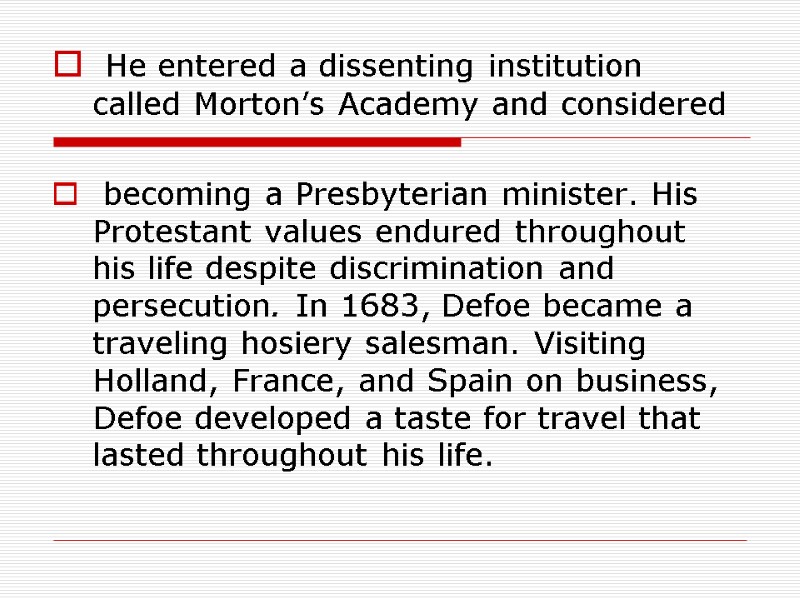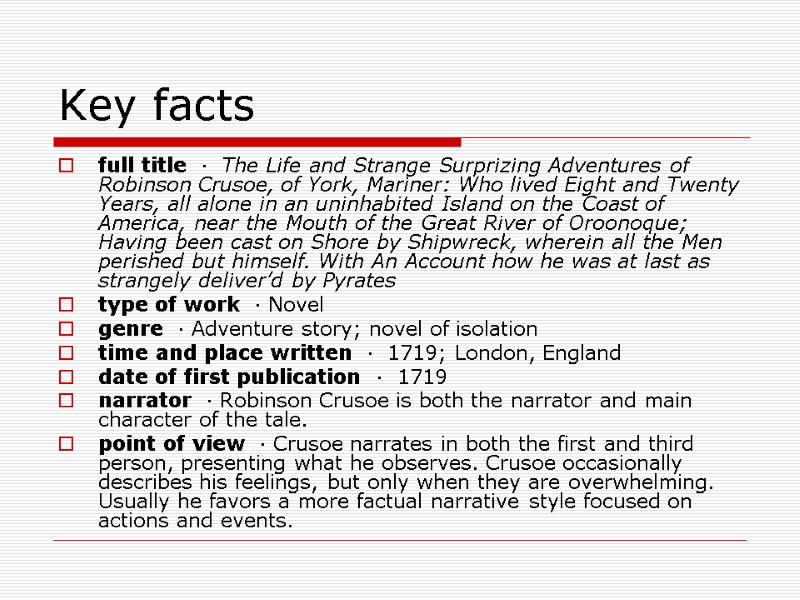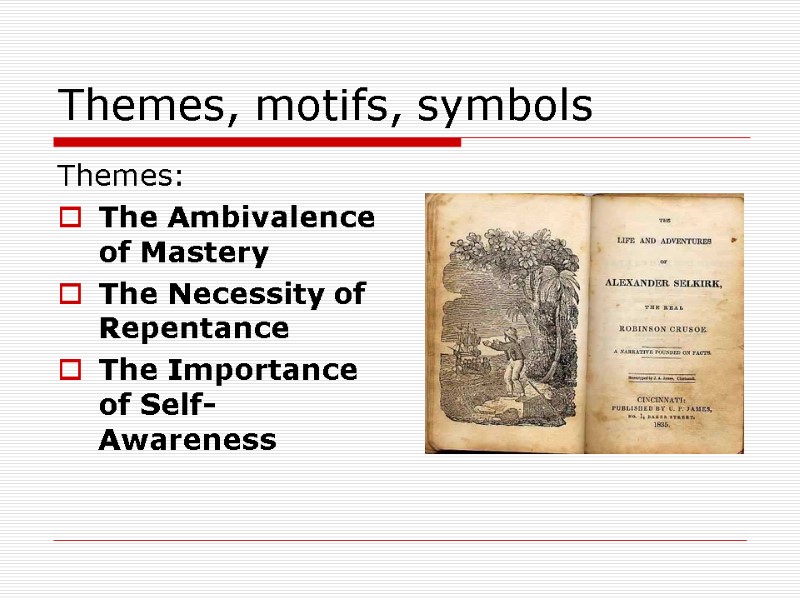Учебный кейс The Enlightenment. Robinson Crusoe by D.


Учебный кейс The Enlightenment. Robinson Crusoe by D. Defoe.

Scheme of Study

The Enlightenment The history of England in the second half of the 17th.c. and during all of the 18th.c. was marked by British colonial expansion and the struggle for the leading role in commerce. The most active sections of the population at the time were the commercial classes that are the middle classes. They hated prejudice and lived by common sense; it was a sound – thinking and rational age. The writers and philosophers of this age, reflecting the ideology of the middle class, protested against the survivals of feudalism, in which they saw the main evils of the time.

They could not yet see the contradictions that were to arise within the capitalist system. Man, they thought, was perfect by nature and vice, bad qualities of human nature were due to ignorance only; so they started a public movement for enlightening the people. The enlighteners wanted to bring knowledge that is ‘light’ to the people. To their understanding this would do away with all the evils of society, and social harmony would be achieved. This movement was called the Enlightenment. Since the enlighteners believed in the power of reason, the period was also called the Age of Reason.

Daniel Defoe was born in 1660, in London, and was originally christened Daniel Foe, changing his name around the age of thirty-five to sound more aristocratic. Like his character Robinson Crusoe, Defoe was a third child. His mother and father, James and Mary Foe, were Presbyterian dissenters. James Foe was a middle-class wax and candle merchant. As a boy, Daniel witnessed two of the greatest disasters of the seventeenth century: a recurrence of the plague and the Great Fire of London in 1666. These events may have shaped his fascination with catastrophes and survival in his writing. Defoe attended a respected school in Dorking, where he was an excellent student, but as a Presbyterian, he was forbidden to attend Oxford or Cambridge.

He entered a dissenting institution called Morton’s Academy and considered becoming a Presbyterian minister. His Protestant values endured throughout his life despite discrimination and persecution. In 1683, Defoe became a traveling hosiery salesman. Visiting Holland, France, and Spain on business, Defoe developed a taste for travel that lasted throughout his life.

Daniel Defoe Defoe began writing fiction late in life, around the age of sixty. He published his first novel, Robinson Crusoe, in 1719, attracting a large middle-class readership. He followed in 1722 with Moll Flanders, the story of a tough, streetwise heroine whose fortunes rise and fall dramatically. Both works straddle the border between journalism and fiction. Robinson Crusoe was based on the true story of a shipwrecked seaman named Alexander Selkirk and was passed off as history, while Moll Flanders included dark prison scenes drawn from Defoe’s own experiences in Newgate and interviews with prisoners. His focus on the actual conditions of everyday life and avoidance of the courtly and the heroic made Defoe a revolutionary in English literature and helped define the new genre of the novel.

Stylistically, Defoe was a great innovator. Defoe used the simple, direct, fact-based style of the middle classes, which became the new standard for the English novel. With Robinson Crusoe’s theme of solitary human existence, Defoe paved the way for the central modern theme of alienation and isolation.

Robinson Crusoe Robinson Crusoe is an Englishman from the town of York in the seventeenth century, the youngest son of a merchant of German origin. Encouraged by his father to study law, Crusoe expresses his wish to go to sea instead. His family is against Crusoe going out to sea, and his father explains that it is better to seek a modest, secure life for oneself. Initially, Robinson is committed to obeying his father, but he eventually succumbs to temptation and embarks on a ship bound for London with a friend.

The major characters Robinson’s resourcefulness in building a home, dairy, grape arbor, country house, and goat stable from practically nothing is clearly remarkable. The Swiss philosopher Jean-Jacques Rousseau applauded Crusoe’s do-it-yourself independence, and in his book on education, Emile, he recommends that children be taught to imitate Crusoe’s hands-on approach to life.

Crusoe’s business instincts are just as considerable as his survival instincts: he manages to make a fortune in Brazil despite a twenty-eight-year absence and even leaves his island with a nice collection of gold. Crusoe prefers to depict himself as an ordinary sensible man, never as an exceptional hero.

The major characters Friday Probably the first nonwhite character to be given a realistic, individualized, and humane portrayal in the English novel, Friday has a huge literary and cultural importance. If Crusoe represents the first colonial mind in fiction, then Friday represents not just a Caribbean tribesman, but all the natives of America, Asia, and Africa who would later be oppressed in the age of European imperialism.

Key facts full title · The Life and Strange Surprizing Adventures of Robinson Crusoe, of York, Mariner: Who lived Eight and Twenty Years, all alone in an uninhabited Island on the Coast of America, near the Mouth of the Great River of Oroonoque; Having been cast on Shore by Shipwreck, wherein all the Men perished but himself. With An Account how he was at last as strangely deliver’d by Pyrates type of work · Novel genre · Adventure story; novel of isolation time and place written · 1719; London, England date of first publication · 1719 narrator · Robinson Crusoe is both the narrator and main character of the tale. point of view · Crusoe narrates in both the first and third person, presenting what he observes. Crusoe occasionally describes his feelings, but only when they are overwhelming. Usually he favors a more factual narrative style focused on actions and events.

Key facts major conflict · Shipwrecked alone, Crusoe struggles against hardship, privation, loneliness, and cannibals in his attempt to survive on a deserted island. rising action · Crusoe disobeys his father and goes out to sea. Crusoe has a profitable first merchant voyage, has fantasies of success in Brazil, and prepares for a slave-gathering expedition. climax · Crusoe becomes shipwrecked on an island near Trinidad, forcing him to fend for himself and his basic needs. falling action · Crusoe constructs a shelter, secures a food supply, and accepts his stay on the island as the work of Providence. themes · The ambivalence of mastery; the necessity of repentance; the importance of self-awareness motifs · Counting and measuring; eating; ordeals at sea symbols · The footprint; the cross; Crusoe’s bower foreshadowing · Crusoe suffers a storm at sea near Yarmouth, foreshadowing his shipwreck years later. Crusoe dreams of cannibals arriving, and later they come to kill Friday. Crusoe invents the idea of a governor of the island to intimidate the mutineers, foreshadowing the actual governor’s later arrival.

Themes, motifs, symbols Themes: The Ambivalence of Mastery The Necessity of Repentance The Importance of Self-Awareness

Themes, motifs, symbols Motifs: Counting and Measuring Eating Ordeals at Sea

Symbols: The Footprint The Cross Crusoe’s Bower

11910-srsp_the_enlightenment..ppt
- Количество слайдов: 18

